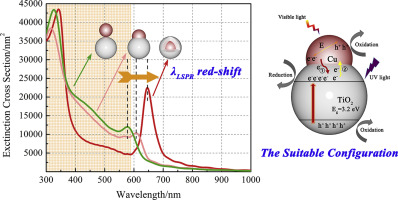当前位置:
X-MOL 学术
›
Sol. Energy Mater. Sol. Cells
›
论文详情
Our official English website, www.x-mol.net, welcomes your feedback! (Note: you will need to create a separate account there.)
Theoretical calculations for localized surface plasmon resonance effects of Cu/TiO2 nanosphere: Generation, modulation, and application in photocatalysis
Solar Energy Materials and Solar Cells ( IF 6.9 ) Pub Date : 2020-05-01 , DOI: 10.1016/j.solmat.2019.110385 Guo-Ying Yao , Zong-Yan Zhao , Qing-Lu Liu , Xu-Dong Dong , Qing-Meng Zhao
Solar Energy Materials and Solar Cells ( IF 6.9 ) Pub Date : 2020-05-01 , DOI: 10.1016/j.solmat.2019.110385 Guo-Ying Yao , Zong-Yan Zhao , Qing-Lu Liu , Xu-Dong Dong , Qing-Meng Zhao

|
Abstract The localized surface plasmon resonance (LSPR) is considered as one of the effective strategies to broaden the spectral absorption range and improve quantum conversion efficiency or photocatalyst. Because of low-cost and LSPR absorption peaks in the visible-light region, Cu-based plasmonic photocatalysts have attracted concern in recent years. However, the mechanisms of generation, modulation, and application of LSPR effects of Cu nanoparticles are still insufficient. To this regard, by using finite-difference time-domain simulations and density functional theory calculations, the intrinsic mechanism of LSPR in the system of Cu nanosphere loaded onto TiO2 nanosphere has been systematically analyzed. When Cu nanosphere is gradually sinking into TiO2 nanosphere to form core-shell configuration, the LSPR absorption peaks is gradually red-shifting and separated from the interband region of metallic Cu nanosphere. The interfacial electronic states are the root of enhancement and red-shifting of LSPR absorption peaks in Cu/TiO2 nanospheres. What's more, the LSPR effects of different Cu/TiO2 nanosphere configurations are highly susceptible to the dielectric media with high refractive index, the direction of incidence light, and environmental media. The embedding configuration of Cu/TiO2 nanospheres is predicted to present outstanding photocatalytic performance, owing to less affected by the incident direction of light, effectively excited LSPR wavelength and local electric field, and more reaction sites for photo-redox reaction. The findings in the present work provide a convenient and efficient approach to screen plasmonic photocatalysts for efficient solar energy conversion.
中文翻译:

Cu/TiO2纳米球局域表面等离子体共振效应的理论计算:光催化的产生、调制和应用
摘要 局域表面等离子体共振(LSPR)被认为是拓宽光谱吸收范围和提高量子转换效率或光催化剂的有效策略之一。由于低成本和可见光区域的 LSPR 吸收峰,Cu 基等离子体光催化剂近年来引起了人们的关注。然而,Cu纳米颗粒的LSPR效应的产生、调制和应用机制仍然不足。对此,通过使用有限差分时域模拟和密度泛函理论计算,系统地分析了负载在 TiO2 纳米球上的 Cu 纳米球体系中 LSPR 的内在机制。当Cu纳米球逐渐沉入TiO2纳米球形成核壳构型时,LSPR 吸收峰逐渐红移并与金属 Cu 纳米球的带间区域分离。界面电子态是 Cu/TiO2 纳米球中 LSPR 吸收峰增强和红移的根源。此外,不同Cu/TiO2纳米球配置的LSPR效应对高折射率介电介质、入射光方向和环境介质高度敏感。由于受光入射方向的影响较小,有效激发了 LSPR 波长和局部电场,以及更多的光氧化还原反应位点,Cu/TiO2 纳米球的嵌入构型有望呈现出优异的光催化性能。
更新日期:2020-05-01
中文翻译:

Cu/TiO2纳米球局域表面等离子体共振效应的理论计算:光催化的产生、调制和应用
摘要 局域表面等离子体共振(LSPR)被认为是拓宽光谱吸收范围和提高量子转换效率或光催化剂的有效策略之一。由于低成本和可见光区域的 LSPR 吸收峰,Cu 基等离子体光催化剂近年来引起了人们的关注。然而,Cu纳米颗粒的LSPR效应的产生、调制和应用机制仍然不足。对此,通过使用有限差分时域模拟和密度泛函理论计算,系统地分析了负载在 TiO2 纳米球上的 Cu 纳米球体系中 LSPR 的内在机制。当Cu纳米球逐渐沉入TiO2纳米球形成核壳构型时,LSPR 吸收峰逐渐红移并与金属 Cu 纳米球的带间区域分离。界面电子态是 Cu/TiO2 纳米球中 LSPR 吸收峰增强和红移的根源。此外,不同Cu/TiO2纳米球配置的LSPR效应对高折射率介电介质、入射光方向和环境介质高度敏感。由于受光入射方向的影响较小,有效激发了 LSPR 波长和局部电场,以及更多的光氧化还原反应位点,Cu/TiO2 纳米球的嵌入构型有望呈现出优异的光催化性能。



























 京公网安备 11010802027423号
京公网安备 11010802027423号